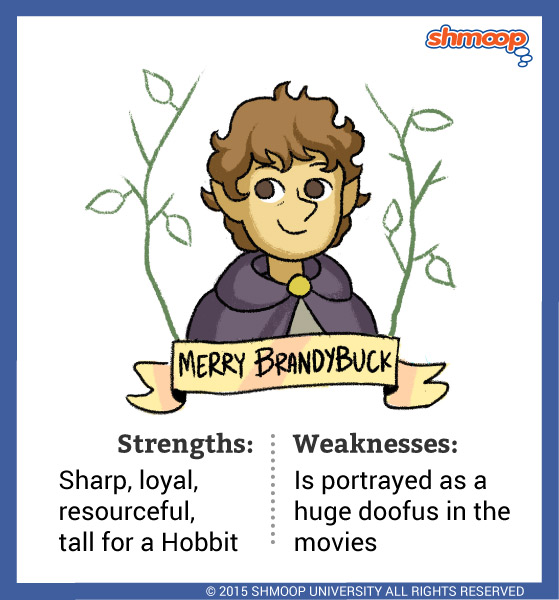Character Analysis

(Click the character infographic to download.)
Note: Before we jump into discussing Merry in The Two Towers, you might want to take a peek at Merry's "Character Analysis" for The Fellowship of the Ring for some background.
In our learning guide for The Fellowship of the Ring, we said that both Merry and Pippin are mainly there for comic relief. And we stand by that character description for The Two Towers. Book-Merry may be a little more serious than Movie-Merry (for proof, just take a peek at this picture), but even Book-Merry is pretty light-hearted. He's not as likely to jump into Serious Philosophical Discussion as his cousin, Frodo.
But when we get to The Two Towers, we see a new and more serious side of Merry. Of course, it makes perfect sense that Merry might stop laughing and start getting serious when he has been kidnapped by a horde of marauding orcs from Isengard. That seriousness only deepens when Merry receives a knife wound on his forehead that leaves a scar.
In fact, you might think of that scar as an outward display of his internal changes. Following his abduction, he becomes more serious about the war effort to resist Sauron and his minions. When Merry and Pippin join the Ents of Fangorn, it is Merry who insists that the Ents have to rally against Saruman and his growing violence. The hobbits both see that neither the Ents nor the hobbits can afford to be passive in the face of such a threat.
Merry and the Ents

(Click the infographic to download.)
Merry, Pippin, and the Ents all get along amazingly well. It's surprising because the Ents are very sloooooooooow in everything they do, while Merry and Pippin both run around like guys on too much Red Bull. We guess that opposites attract in this case, since the Ents are old and wise and the hobbits are young and, well, not the sharpest tacks in the box. But this meeting of the minds between Fangorn, Merry, and Pippin proves the old saying that the enemy of your enemy is your friend: even though the Ents and the hobbits seem as different as can possibly be, they bond over sharing a common enemy, Saruman. At the end of the day, that's what counts.
Merry the War Hero
On top of his experiences with the orcs of Isengard and the Ents of Fangorn Forest, Merry has one other major claim to fame in The Two Towers: he starts to make friends with King Théoden over a pipeful of tobacco in the ruins of Saruman's fortress. The whole scene is a bit strange, to be honest. Théoden meets Merry and Pippin after his own defense of his people at Helm's Deep and after the downfall of Saruman at Isengard. So, instead of giving us a blow-by-blow of the battle of Isengard as it happens, Tolkien gives a recap, in Merry's voice, long after the battle has been fought.Why doesn't Tolkien give us a live play-by-play? Well, we think Merry tells about the fall of Isengard in his own words because Tolkien is less interested in the mechanics of war itself. Instead, he wants to focus on how the war affects characters like Merry and Pippin, and that's something he can only convey through Merry's version of events. Even though the whole Lord of the Rings trilogy focuses on a war between Good and Evil, the emotional states of the characters are always front and center, and sometimes the action has to take a backseat.
That's why the most heroic act in the novel is Frodo's quiet resistance to the dark forces of the Ring, rather than the huge battles that rock Gondor and Rohan. This book always brings everything back to the human (or in this case, hobbit) scale. Merry's first-person account of what happens to Saruman is further proof of Tolkien's interest in people, rather than in the supposed glories of war itself.